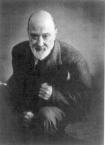
This week I've decided to go back and revisit some works of music and writing that have been crucial to my perceptions, and thus my own expression. I've chosen three to re-explore and write about. I'll begin with the American composer Charles Ives's orchestral work, THREE PLACES IN NEW ENGLAND(composed between 1903-1914.)
I first heard THREE PLACES IN NEW ENGLAND on an LP my dad brought home sometime in the late 60s. He'd bought it for Copland's LINCOLN PORTRAIT, but it was the Ives piece that captured me. I have strong memories of listening to it with one ear to our old Magnavox mono rig; the smell of hot tubes is somehow tied forever in my sensory memory to Ives's orchestral triptych. It's probably been ten years now since I've last heard it, so this morning-- a hazy, humid, summer-like one, as befits the first of June-- I sat down with coffee and listened closely.
The first section honors the famous St. Gaudens Bas-relief sculpture dedicated to Colonel Shaw's black Civil War regiment in the Boston Common. Like most of Ives's music, this composition is spacious and feels "outdoors" to me; there is light and sound and silence, and the sections and voices of the orchestra are arrayed to magnify that sense of spaciousness. The dominant harmonic colors, applied to snatches of hymns and ghostly song fragments, are like a more tart and polytonal take on the chromatic exoticism of Wagner and Debussy; but the overall effect is less heroic and monolithic than Wagner, less nocturnal and dreamlike than Debussy. This is, instead, music for bright light and clean, open air.
Like St. Gauden's fluid and classical approach to representational sculpture, Ives's music here evinces a sense of heroism tempered with compassionate humanity; there's all that open space and landscape, and the hymns provide a sense of history, community, and human continuity. Especially powerful is the way the constantly shifting textures-- the piano and contra-bass provide a particularly questing restlessness-- seem to find occasional fleeting resolution in one repeated, haunting hymnal motif.
The second place Ives visits is another war memorial. In "Putnam's Camp, Redding, Connecticut", the composer returns to childhood memories of outdoor picnics on the site of a Revolutionary War battle. It's a wild and raucous piece, with Ives's usual weave of hymns and marches. But there are quiet moments here and there, too, and these shifts in mood bring, to my ears, a morphing between Ives's childhood memories and the more ancient time-frame of the Revolutionary battle itself; thus this music becomes evocative of time and history in layers, of both history and personal memory. This layering could not be better sonically manifested than it is near the end of the piece, when a martial, elegiac, bugle-like horn melody on the far right horizon is subsumed by the same note played, on the left horizon, by a hollow, ethereal, thrush-like flute-- suggesting, perhaps, the ultimate merging of human history with the natural world.
Personal history and the natural landscape of New England are at the heart of the final movement, "The Housatonic at Stockbridge." Here Ives revisits a memory of a walk with his wife along the river. This is water music at its most evocative; music that flows and eddies and pulses and moves with a lush combination of impressionist harmony and tight, poly-chromatic dissonance. Ives brings the memory of moving river waters to life here, ending the piece abruptly --and emotionally-- with one of his yearning, questing, hymn motifs.
(I should add that the CD I listened to this morning-- Michael Tilson Thomas conducting the Boston Symphony Orchestra in 1970 (DG 463 633) --offers an interpretation and recording that is very satisfying in its spaciousness, clean sonics, and dynamic range.)
I heard in Ives's THREE PLACES IN NEW ENGLAND this morning the same things I heard-- and loved -- when I was ten years old: evocation of place and history, of landscape and nature, of the unique clear and spacious light that suffuses the New England latitudes. And, certainly, I can hear how those things have stayed deep inside me to inspire my own writing and musical composition.